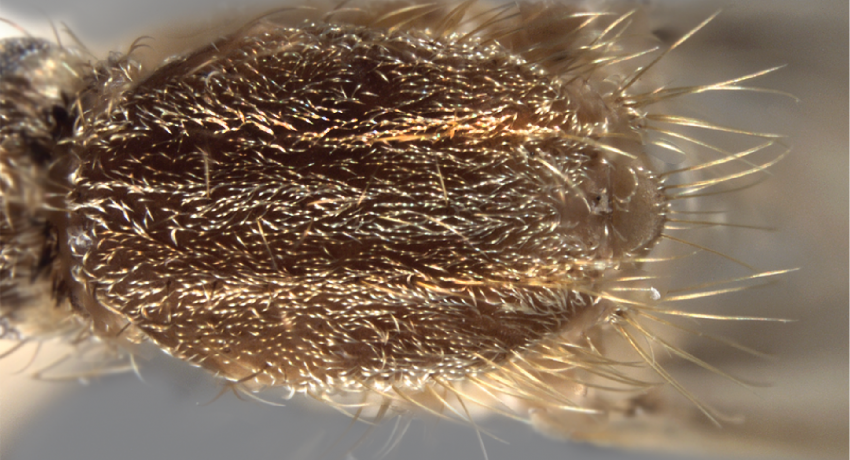AFROTROPICAL REGION
Informal name: Yellow Zimbabwean Pointy Mosquito
Etymology: pale yellow (Gr); overall yellow color
Aedes ochraceus is the monotypic member of the Ochraceus Group. Although present in all African countries south of the Sahel, it is more prevalent in the East. It is highly recognizable, with distinctive adult characteristics, and an elongated siphon in the larval stage.
Type locality: Salisbury, Mashonaland [Zimbabwe]
Type depository: Natural History Museum, London, England, United Kingdom (NHMUK)
DIAGNOSTIC CHARACTERS (Click photos to view; mouse over and click large photo to zoom in.)
ADULT (illustrated): Thorax: Scutum with stripes of yellow and brown scales. Wing: Costa yellow-scaled. Legs: Tarsomeres lack distinct pale bands; all tibia and femura with longitudinal yellow stripes bordered by dark stripes.
LARVA (not illustrated): Head: Setae 5–7-C plumose, each c. 8-branched. Terminal abdominal segments: Comb with comb scales basally fringed, in irregular patch of 8–11; seta 1-S small, inserted c. 0.67 from base; Pecten with 13–18 spines, widely spaced distally; siphon long, index 6.0–8.0.
TAXONOMIC KEYS
Jupp 1996
Exemplar DNA sequences
Ae. ochraceus COI: KU187000–01
BIONOMICS
Immatures
Aedes ochraceus is a floodwater mosquito. Females oviposit directly into the surface layer of the soil in wooded savannahs, in places that are liable to future flooding.
Adults
Aedes ochraceus is an important vector of several impactful human arboviruses. During the 2006–2007 RVFV outbreak in Garissa, Kenya, Ae. ochraceus was by far the dominant species in all catches (76%). Here Ae. ochraceus to feed preferentially on goats (37.6%), cattle (16.4%), donkeys (10.7%), and sheep, but also on humans (5.3%). At high densities, Ae. ochraceus can become abundant and a nuisance to man.
DISTRIBUTION NOTES
Burkina Faso, Ethiopia, Ghana, Kenya, Mali, Mozambique, Namibia, Nigeria, Senegal, South Africa, Sudan & South Sudan, Zambia, Zimbabwe

WRBU VECTOR HAZARD REPORTS
None; View other WRBU Vector Hazard Reports
Available GIS Models
IMPORTANT REFERENCES (full citations below)
Edwards 1941: 200 (M, F*)
Hopkins 1952: 207 (L*)
Qutubuddin 1959: 22 (M*)
Pao & Knight 1970a: 114 (L*)
McIntosh 1975: 284 (M*, F*, L; distribution)
Jupp 1996 (F*; key)
CURRENT SYNONYMS
syn. kingii Theobald
1908c: 258 (M, F*; Mimeteculex). Type locality: Faufikia, Upper White Nile, Sudan (NHMUK).
CITED REFERENCES
Edwards, F.W. (1941). Mosquitoes of the Ethiopian Region. III. Culicine adults and pupae. Bulletin of the British Museum (Natural History) Entomology.
Hopkins, G.H.E. (1952). Mosquitoes of the Ethiopian region. I. Larval bionomics of mosquitoes and taxonomy of culicine larvae (2nd ed.). London, UK: British Museum (Natural History).
Jupp, P.G. (1996). Mosquitoes of southern Africa. Culicinae and Toxorhynchitinae. Ekogilde Publishers, Hartebeespoort, South Africa. 156pp.
McIntosh, B.M. (1975). A taxonomic revision of certain Aedes species (Diptera: Culicidae) of the subgenus Aedimorphus in Southern Africa. Journal of the Entomological Society of Southern Africa, 38(2), 251–287.
Pao, B., & Knight, K.L. (1970a). The fourth instar larval mandible and maxilla of selected Aedes (Aedimorphus) species (Diptera, Culicidae). Mosquito Systematics, 2(3), 98–131.
Qutubuddin, M. (1959). A new species of Aedimorphus (Diptera: Culicidae) from Sudan Republic. Annals and Magazine of Natural History, 2(13), 21–23.
Theobald, F.V. (1908c). New mosquitoes from the Sudan with list and synoptic table of all the known Sudanese species. Retrieved from Wellcome Research Laboratory Report, Khartoum.
CITE THIS PAGE
Walter Reed Biosystematics Unit (Year). Aedes ochraceus species page. Walter Reed Biosystematics Unit Website, http://wrbu.si.edu/vectorspecies/mosquitoes/ochraceus, accessed on [date (e.g. 03 February 2020) when you last viewed the site].










































































































































































